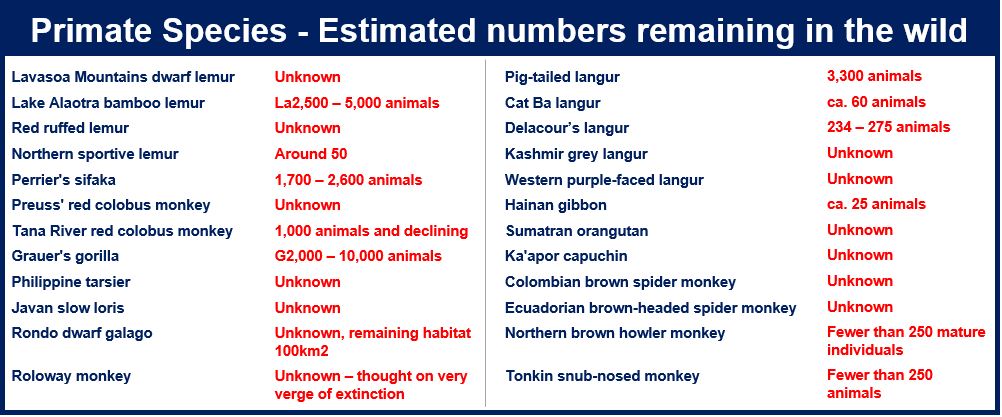Over half of all primate species are today classified as threatened with extinction, due mainly to habitat loss, particularly from the clearing and burning of tropical forests, illegal wildlife trade, and the hunting of primates for food, according to a list compiled by the Bristol Zoological Society, Conservation International, the International Primatological Society, and the Primate Specialist Group of IUCN’s Species Survival Commission.
Some new species have been added to the threatened list, which is updated every two years, including the Lavasoa Mountains dwarf lemur and Philippine tarsier.
Just 25 wild Hainan gibbons left
There are only 25 individual Hainan gibbons left in the wild. According to the Zoological Society of London, the Hainan gibbon is the world’s rarest ape, rarest primate, and likely the rarest mammal species.
 The world’s rarest primate – the Hainan Gibbon. Just 25 wild ones left. (Image: The Zoological Society of London)
The world’s rarest primate – the Hainan Gibbon. Just 25 wild ones left. (Image: The Zoological Society of London)
In the 1950s there were about 2,000 Hainan gibbons in the wild. Today they are restricted to a single patch of forest in Bawangling National Nature Reserve on Hainan Island, China.
Similarly, there are just 50 Northern sportive lemurs left in the wild – all of them in Madagascar. Also known as the Sahafary sportive lemur or Northern weasel lemur, it has suffered severe ecological and human pressures.
Threatened primate species across the globe
The IUCN Red List of Threatened Species includes five primate species from Madagascar, five from Africa, five from Central and South America, and ten from Asia. They are all in need of urgent conservation action, says the Bristol Zoological Society.
The list was drawn up by primatologists working in the field who have first-hand exprence of the causes of threats to primates. World-leading primatologist, Dr. Christoph Schwitzer, Director of Conservation at Bristol Zoological Society, was one of the editors of the report.
Regarding the significance of the report, Dr. Schwitzer said:
“This research highlights the extent of the danger facing many of the world’s primates. We hope it will focus people’s attention on these lesser known primate species, some of which most people will probably have never heard of, such as the Lavasoa Mountains dwarf lemur from Madagascar – a species only discovered two years ago – or the Roloway monkey from Ghana and Ivory Coast, which we believe is on the very verge of extinction.”
“Some of these animals have tiny populations remaining in the wild and support and action to help save them is vital if we are to avoid losing these wonderful animals forever.”
 Every two years, the list of threatened primate species gets longer. (Source: Bristol Zoological Society)
Every two years, the list of threatened primate species gets longer. (Source: Bristol Zoological Society)
Larger primates prime targets for bushmeat hunting
Vietnam and Madagascar both have several highly threatened primate species. In Africa, the genus of the red colobus monkeys is under severe threat, as are several of the spider monkeys and howler monkeys of South America. All of these species are fairly large and conspicuous, making them vulnerable targets for bushmeat hunting.
Dr. Russell Mittermeier, Chair of the IUCN/SSC Primate Specialist Group and Executive Vice Chair of Conservation International, explained:
“The purpose of our Top 25 list is to highlight those primates most at risk, to attract the attention of the public, to stimulate national governments to do more, and especially to find the resources to implement desperately needed conservation measures. In particular, we want to encourage governments to commit to desperately needed biodiversity conservation measures.”
“What is more, beyond the great scientific interest of primates, there is increasing evidence that certain species may play a key role in dispersing the seeds of tropical forest tree species that have a critically important role in mitigating climate change – a particularly noteworthy consideration given the upcoming conference of the parties of the climate convention in Paris.”
 There are just 50 Northern Sportive Lemurs left in the wild. (Image: madagascarpartnership.org)
There are just 50 Northern Sportive Lemurs left in the wild. (Image: madagascarpartnership.org)
SOS (Save Our Species), an initiative managed by IUCN, announced in October locally-implemented projects to protect the Alaotra gentle lemur and Northern sportive lemur. Even so, SOS emphasizes, much still needs to be done for other species.
Dr Schwitzer said:
“This report makes scary reading for primatologists and the public alike, and highlights where we as conservationists must focus our attention over the coming years. However, it also demonstrates the growing importance of collaboration between the international conservation, research and zoo communities in the protection of species and habitats.”
“At Bristol Zoological Society we will continue our conservation and research with the aim of increasing the effectiveness of the conservation activities, as well as increasing our understanding of these, and other, critically endangered species.”
The report of the 25 most endangered primates in the world was compiled by 63 experts from across the globe. It was launched at Singapore Zoo today (24 November) with guests from national research and conservation organisations.
Video – Orangutans
In this video, David Attenborough introduces a female orangutan washing socks with soap and water – because she saw people doing it – an instinct that ultimately led to the transformation of the world.
